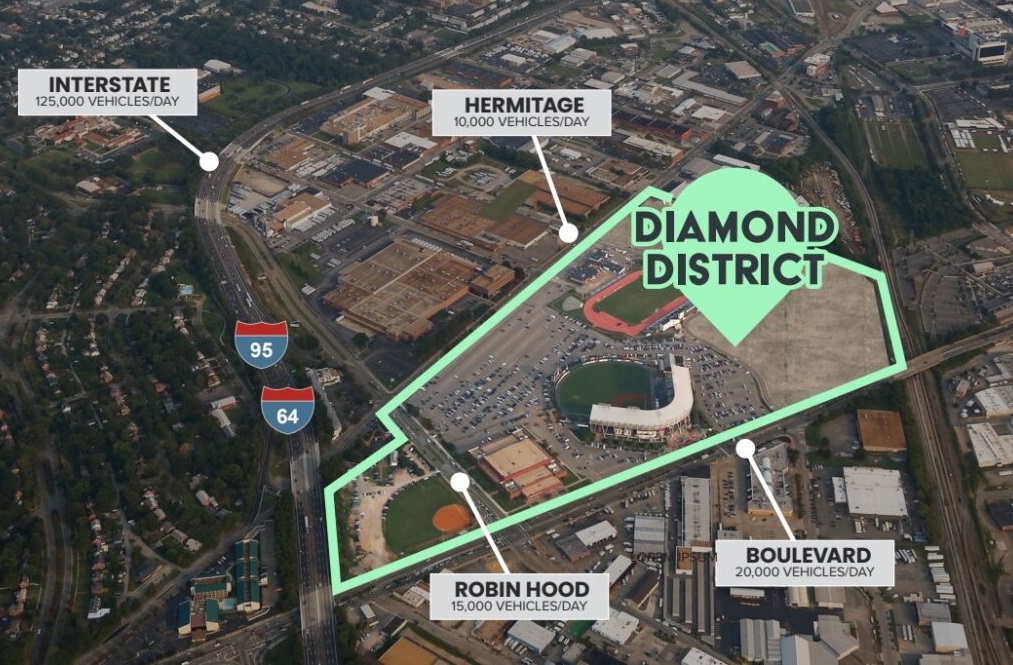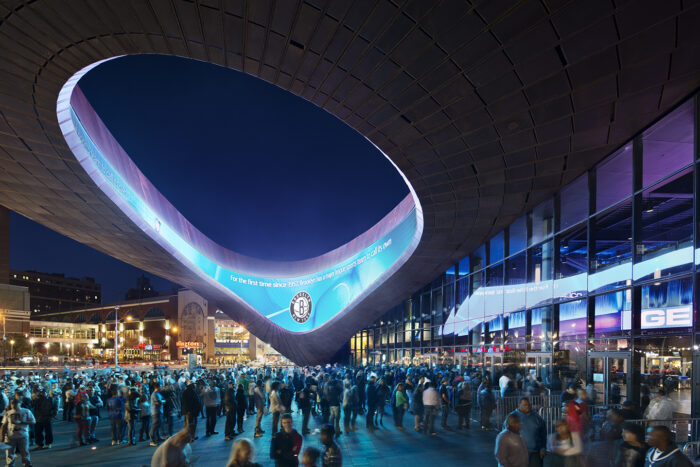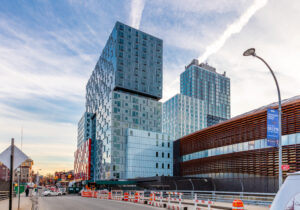
The 60-plus acres of the Diamond District are bordered by Arthur Ashe Boulevard, Hermitage Road, the interstate and the railroad tracks. (BizSense file images)
An East Coast developer and a West Coast peer are teaming up in a bid to score Richmond’s Diamond District project.
New York-based MAG Partners and Seattle-based MacFarlane Partners are driving one of the six teams that remain in contention for the mixed-use redevelopment of city-owned land that would include a replacement of The Diamond baseball stadium.
MAG is led by MaryAnne Gilmartin, whose development credits include Brooklyn’s Barclays Center arena and surrounding Pacific Park Brooklyn mixed-use development. Other projects include the New York Times headquarters building and the 76-story New York by Gehry skyscraper.
Gilmartin, who founded MAG in 2020, helped drive those efforts during her years as an executive with Forest City Ratner Cos., the last five as its CEO. (Forest City worked on Barclays with David Carlock of Machete Group, a venue advisory firm that’s leading a separate Diamond District contender team).
MacFarlane Partners – not to be confused with the similarly named Richmond firm led by local developer Charles Macfarlane – is a 35-year-old company whose development work includes a 54-story hotel and condo high-rise at L.A. Live, an entertainment complex in downtown Los Angeles.
Led by Victor MacFarlane, the company is one of the largest black-owned development firms in the country, according to Gilmartin, who said they’ve collaborated on other projects.
Also on the team is Jair Lynch Real Estate Partners, a D.C.-based development firm that was one of the 15 respondents to the Diamond District’s initial request-for-interest solicitation. Gilmartin said Jair Lynch joined their team in recent weeks after its RFI response didn’t make the latest cut. The company has a focus in multifamily residential development.
Another recent addition is MSquared, a real estate development and investment firm led by Alicia Glen, a former New York City deputy mayor under the Bill de Blasio administration.
Rounding out the team are architecture firms AtelierTek and Woods Bagot; engineering firm Kimley-Horn, which has an office in Richmond; sports venue developer CAA Icon, whose stadium-related work includes Chicago’s 1060 Project and Guaranteed Rate Field; placemaking and workforce firm C Space; and structural engineering firm Thornton Tomasetti.
With its team, Gilmartin said in an interview this week, “I would submit that we have to have among the most diverse group of talent in the mix for this RFP response, just because I know how hard it is to put a team like this together.
“We really like what the government’s done by way of organizing this RFP. It’s ambitious, it’s got scale, and as a result, we put together a team that goes far beyond just the resumes and credentials of MAG Partners,” she said.
Gilmartin said her firm had identified Richmond as an emerging market it wanted to do business in when the Diamond District RFI showed up on its radar, leading to discussions with MacFarlane and Jair Lynch. She said Richmond’s culture, food scene and evolving demographics make it ripe to become one of the country’s next hot spots.
“We have a lot still to learn, but what we do know about Richmond is super-exciting to us. We think it’s a city to watch, for sure,” she said.
“As my team particularly was part of the renaissance of Brooklyn – we spent a lot of time helping to create a place in Brooklyn at a time when it really didn’t have the halo effect that it has today – we learned a lot along the way, and what we see in Richmond really lines up with what we are doing in our careers.”

Brooklyn’s Barclays Center arena, which opened in 2012, anchors the larger Pacific Park Brooklyn mixed-use development that likewise involved MAG Partners’ MaryAnne Gilmartin. (Images courtesy MAG Partners)
While different in market and scale, Gilmartin said the 67-acre Diamond District project is similar to the 8-acre Pacific Park Brooklyn development that’s anchored by Barclays Center, home to the NBA’s Brooklyn Nets and WNBA’s New York Liberty.
“It really was the cornerstone to kick off the overall large-scale development, because it’s got public purpose and delivers a ton for the community. We see the Richmond RFP in a very similar way,” she said.
“It was a controversial project in its inception. One of the reasons why I think it’s been widely accepted by people in Brooklyn is that it is a very good neighbor, in terms of the way it’s been planned, the way it was constructed, the way that it operates. All of that was due to the work we put in for years and years.”
Gilmartin said her team would take a similar approach to the Diamond District, bringing with it lessons they learned from over a decade working on Barclays and Pacific Park Brooklyn.
“The only way to really know how to do it is to have done it,” she said. “All of that experience will be brought to bear in Richmond. The public trust that underlies that commitment needs to be honored, and that’s something that I think we are uniquely capable of doing.”
MAG’s team is one of six that the city is considering for the next stage in the process: an invitation for development proposals. After getting picked among the initial 15 RFI respondents, the teams were asked to provide additional information about themselves and how they would approach the project. The deadline for those details is this Monday, April 25.
An evaluation panel would then select a shortlist of finalists, who would be invited to submit proposals by early June. A final selection is targeted later that month.
In addition to a new, 10,000-capacity stadium to replace the 37-year-old Diamond, which has been deemed unfeasible for renovation, the Diamond District project calls for a mix of development including office, residential, retail and a hotel, as well as upgrades to infrastructure such as water, sewer and roads. The residential component would consist of rental and for-sale homes that would include some units targeted to lower-income households.
While local efforts to position the site for redevelopment have ebbed and flowed for over a decade, Gilmartin said the project’s history gives her team confidence that this latest attempt will be seen through – as does Major League Baseball’s deadline for the Richmond Flying Squirrels to find a facility that meets new pro baseball standards by the start of the 2025 season.
“I have a joke that sometimes things have to die three times before they live,” Gilmartin said. “Part of what I like about this is the process has been super-thoughtful, and because it has certain built-in timelines, there’s a certain amount of commitment around this RFP, because of the needs of the Squirrels and some of the other requirements that make us pretty sure something’s going to happen here.”
She added, “It feels right, it feels ready, and it feels highly credentialed on the part of the government.”
Declining to discuss her team’s vision for the project in detail, Gilmartin said they’ve shared more with the city than just their qualifications, and are open to potentially expanding or modifying the team’s makeup as needed for the project. City administrators have said the final selection for the project could be one or more developers or teams for all of parts of the development.
“While I can’t talk about the details, I can tell you that this submission that we’re doing is so much more than introductory,” Gilmartin said. “The level of work and the level of thinking that’s being asked of us is significant, and in my mind, while it’s a ton of work, it also speaks to the legitimacy of the planning organizations, the seriousness of the government to actually do something.”
Regarding arguments over whether the project should be awarded to primarily local or out-of-town teams, Gilmartin added, “We should be always thinking local, but there’s a certain amount of ideas and excitement that can come from opening the team up from beyond just the borders of Richmond and Virginia. It should be inclusive, and it should also have a local lineup.
“If our lineup is not local enough, because we need to bring in more local expertise, we’re completely open to that, and we’ve made that very clear,” she said. “But I also think, having run a company that had 26 offices around the country, we can all learn from each other.
“Obviously Richmond is not Brooklyn,” Gilmartin added, “but at the same time, we think we can contribute in a way that is highly beneficial to the process, and the ideas are probably going to be new. There has been a local effort on this district for quite some time now, and I think that there’s a desire for some new ideas and new thinking. But that doesn’t have to come at the expense of local expertise.”
The other five teams that remain in contention are:
• Diamond District Gateway Partners, consisting of local real estate investment firm Capital Square, D.C.-based developers Dantes Partners and Hoffman & Associates, Maryland-based real estate firm The Velocity Cos., local architecture firm Baskervill and Missouri-based architecture firm Pendulum.
• Richmond Community Development Partners, led by Houston-based Machete Group and consisting of developers JMA Ventures and Sterling Project Development, construction firm Gilbane, hotel management and advisory firm Retro Hospitality, architecture firm Hanbury, engineering firm VHB and planning nonprofit Storefront for Community Design.
• RVA Diamond Partners, team members unknown.
• Vision300 Partners LLC, includes developers Freehold Communities, Greenstone Properties, KDC and Spy Rock Real Estate Group; local building firm Hourigan; housing nonprofit Better Housing Coalition, construction firm Canterbury Enterprises, Shamin Hotels, YMCA of Greater Richmond, Brookfield Asset Management, and Richmond-based Sports United Ltd.
• Weller Development Co. and LMXD, consisting of Weller, a Baltimore-based developer, and LMXD, affiliated with New York-based L+M Development Partners.

The 60-plus acres of the Diamond District are bordered by Arthur Ashe Boulevard, Hermitage Road, the interstate and the railroad tracks. (BizSense file images)
An East Coast developer and a West Coast peer are teaming up in a bid to score Richmond’s Diamond District project.
New York-based MAG Partners and Seattle-based MacFarlane Partners are driving one of the six teams that remain in contention for the mixed-use redevelopment of city-owned land that would include a replacement of The Diamond baseball stadium.
MAG is led by MaryAnne Gilmartin, whose development credits include Brooklyn’s Barclays Center arena and surrounding Pacific Park Brooklyn mixed-use development. Other projects include the New York Times headquarters building and the 76-story New York by Gehry skyscraper.
Gilmartin, who founded MAG in 2020, helped drive those efforts during her years as an executive with Forest City Ratner Cos., the last five as its CEO. (Forest City worked on Barclays with David Carlock of Machete Group, a venue advisory firm that’s leading a separate Diamond District contender team).
MacFarlane Partners – not to be confused with the similarly named Richmond firm led by local developer Charles Macfarlane – is a 35-year-old company whose development work includes a 54-story hotel and condo high-rise at L.A. Live, an entertainment complex in downtown Los Angeles.
Led by Victor MacFarlane, the company is one of the largest black-owned development firms in the country, according to Gilmartin, who said they’ve collaborated on other projects.
Also on the team is Jair Lynch Real Estate Partners, a D.C.-based development firm that was one of the 15 respondents to the Diamond District’s initial request-for-interest solicitation. Gilmartin said Jair Lynch joined their team in recent weeks after its RFI response didn’t make the latest cut. The company has a focus in multifamily residential development.
Another recent addition is MSquared, a real estate development and investment firm led by Alicia Glen, a former New York City deputy mayor under the Bill de Blasio administration.
Rounding out the team are architecture firms AtelierTek and Woods Bagot; engineering firm Kimley-Horn, which has an office in Richmond; sports venue developer CAA Icon, whose stadium-related work includes Chicago’s 1060 Project and Guaranteed Rate Field; placemaking and workforce firm C Space; and structural engineering firm Thornton Tomasetti.
With its team, Gilmartin said in an interview this week, “I would submit that we have to have among the most diverse group of talent in the mix for this RFP response, just because I know how hard it is to put a team like this together.
“We really like what the government’s done by way of organizing this RFP. It’s ambitious, it’s got scale, and as a result, we put together a team that goes far beyond just the resumes and credentials of MAG Partners,” she said.
Gilmartin said her firm had identified Richmond as an emerging market it wanted to do business in when the Diamond District RFI showed up on its radar, leading to discussions with MacFarlane and Jair Lynch. She said Richmond’s culture, food scene and evolving demographics make it ripe to become one of the country’s next hot spots.
“We have a lot still to learn, but what we do know about Richmond is super-exciting to us. We think it’s a city to watch, for sure,” she said.
“As my team particularly was part of the renaissance of Brooklyn – we spent a lot of time helping to create a place in Brooklyn at a time when it really didn’t have the halo effect that it has today – we learned a lot along the way, and what we see in Richmond really lines up with what we are doing in our careers.”

Brooklyn’s Barclays Center arena, which opened in 2012, anchors the larger Pacific Park Brooklyn mixed-use development that likewise involved MAG Partners’ MaryAnne Gilmartin. (Images courtesy MAG Partners)
While different in market and scale, Gilmartin said the 67-acre Diamond District project is similar to the 8-acre Pacific Park Brooklyn development that’s anchored by Barclays Center, home to the NBA’s Brooklyn Nets and WNBA’s New York Liberty.
“It really was the cornerstone to kick off the overall large-scale development, because it’s got public purpose and delivers a ton for the community. We see the Richmond RFP in a very similar way,” she said.
“It was a controversial project in its inception. One of the reasons why I think it’s been widely accepted by people in Brooklyn is that it is a very good neighbor, in terms of the way it’s been planned, the way it was constructed, the way that it operates. All of that was due to the work we put in for years and years.”
Gilmartin said her team would take a similar approach to the Diamond District, bringing with it lessons they learned from over a decade working on Barclays and Pacific Park Brooklyn.
“The only way to really know how to do it is to have done it,” she said. “All of that experience will be brought to bear in Richmond. The public trust that underlies that commitment needs to be honored, and that’s something that I think we are uniquely capable of doing.”
MAG’s team is one of six that the city is considering for the next stage in the process: an invitation for development proposals. After getting picked among the initial 15 RFI respondents, the teams were asked to provide additional information about themselves and how they would approach the project. The deadline for those details is this Monday, April 25.
An evaluation panel would then select a shortlist of finalists, who would be invited to submit proposals by early June. A final selection is targeted later that month.
In addition to a new, 10,000-capacity stadium to replace the 37-year-old Diamond, which has been deemed unfeasible for renovation, the Diamond District project calls for a mix of development including office, residential, retail and a hotel, as well as upgrades to infrastructure such as water, sewer and roads. The residential component would consist of rental and for-sale homes that would include some units targeted to lower-income households.
While local efforts to position the site for redevelopment have ebbed and flowed for over a decade, Gilmartin said the project’s history gives her team confidence that this latest attempt will be seen through – as does Major League Baseball’s deadline for the Richmond Flying Squirrels to find a facility that meets new pro baseball standards by the start of the 2025 season.
“I have a joke that sometimes things have to die three times before they live,” Gilmartin said. “Part of what I like about this is the process has been super-thoughtful, and because it has certain built-in timelines, there’s a certain amount of commitment around this RFP, because of the needs of the Squirrels and some of the other requirements that make us pretty sure something’s going to happen here.”
She added, “It feels right, it feels ready, and it feels highly credentialed on the part of the government.”
Declining to discuss her team’s vision for the project in detail, Gilmartin said they’ve shared more with the city than just their qualifications, and are open to potentially expanding or modifying the team’s makeup as needed for the project. City administrators have said the final selection for the project could be one or more developers or teams for all of parts of the development.
“While I can’t talk about the details, I can tell you that this submission that we’re doing is so much more than introductory,” Gilmartin said. “The level of work and the level of thinking that’s being asked of us is significant, and in my mind, while it’s a ton of work, it also speaks to the legitimacy of the planning organizations, the seriousness of the government to actually do something.”
Regarding arguments over whether the project should be awarded to primarily local or out-of-town teams, Gilmartin added, “We should be always thinking local, but there’s a certain amount of ideas and excitement that can come from opening the team up from beyond just the borders of Richmond and Virginia. It should be inclusive, and it should also have a local lineup.
“If our lineup is not local enough, because we need to bring in more local expertise, we’re completely open to that, and we’ve made that very clear,” she said. “But I also think, having run a company that had 26 offices around the country, we can all learn from each other.
“Obviously Richmond is not Brooklyn,” Gilmartin added, “but at the same time, we think we can contribute in a way that is highly beneficial to the process, and the ideas are probably going to be new. There has been a local effort on this district for quite some time now, and I think that there’s a desire for some new ideas and new thinking. But that doesn’t have to come at the expense of local expertise.”
The other five teams that remain in contention are:
• Diamond District Gateway Partners, consisting of local real estate investment firm Capital Square, D.C.-based developers Dantes Partners and Hoffman & Associates, Maryland-based real estate firm The Velocity Cos., local architecture firm Baskervill and Missouri-based architecture firm Pendulum.
• Richmond Community Development Partners, led by Houston-based Machete Group and consisting of developers JMA Ventures and Sterling Project Development, construction firm Gilbane, hotel management and advisory firm Retro Hospitality, architecture firm Hanbury, engineering firm VHB and planning nonprofit Storefront for Community Design.
• RVA Diamond Partners, team members unknown.
• Vision300 Partners LLC, includes developers Freehold Communities, Greenstone Properties, KDC and Spy Rock Real Estate Group; local building firm Hourigan; housing nonprofit Better Housing Coalition, construction firm Canterbury Enterprises, Shamin Hotels, YMCA of Greater Richmond, Brookfield Asset Management, and Richmond-based Sports United Ltd.
• Weller Development Co. and LMXD, consisting of Weller, a Baltimore-based developer, and LMXD, affiliated with New York-based L+M Development Partners.






These national players are making this competition very interesting. This Diamond District process is far better done than the Navy Hill search and RFP process, so perhaps the City is capable of learning from its mistakes. This could be very exciting for the City’s future.
Ditto
In my opinion” the devil is in the details,” with the overriding question regarding how, and when the new stadium gets built.
Why the Devil may be in the details, I totally disagree that the stadium is the most important detail. To my mind, provincialism should be banished from the room and the two biggest concerns should be the quality, meaning expertise and capitalization of the team AND the plan for what they will do OUSTIDE the stadium —- the mix, kind, and amount invested there. If they will invest the most here, if they have the credentials and $$$$ to make it happen and the things the build will be deemed the best for the area — that should cinch it,… Read more »